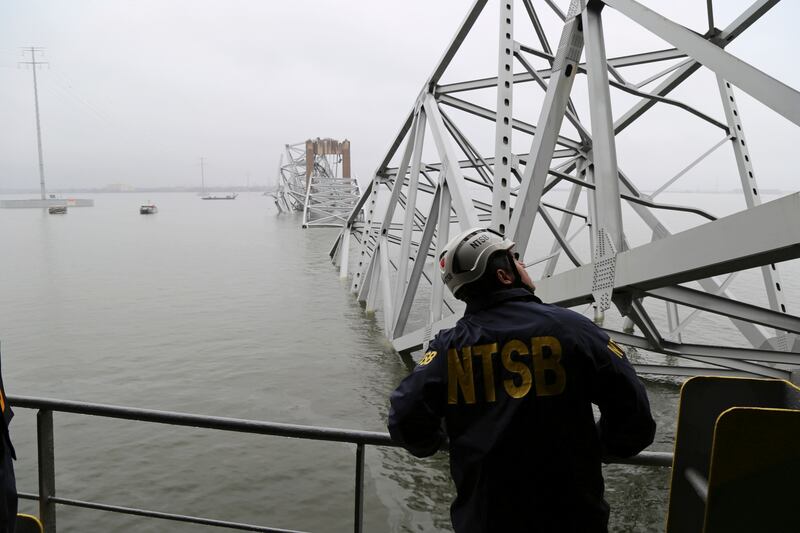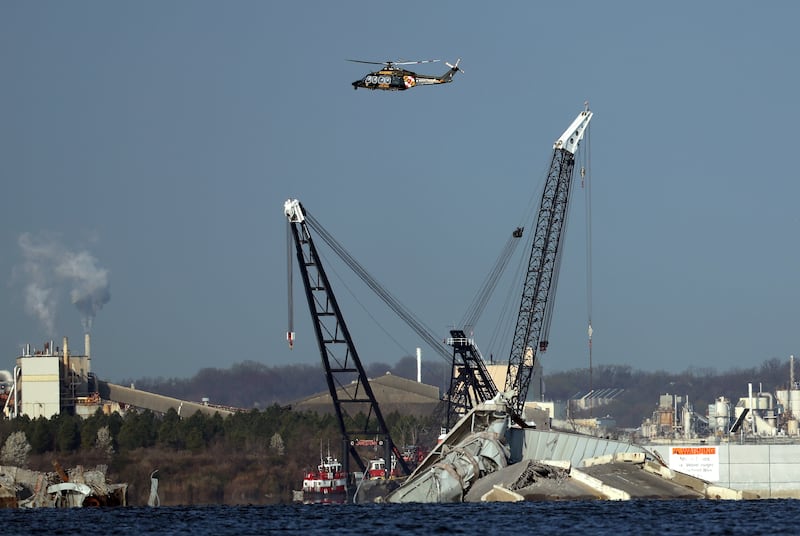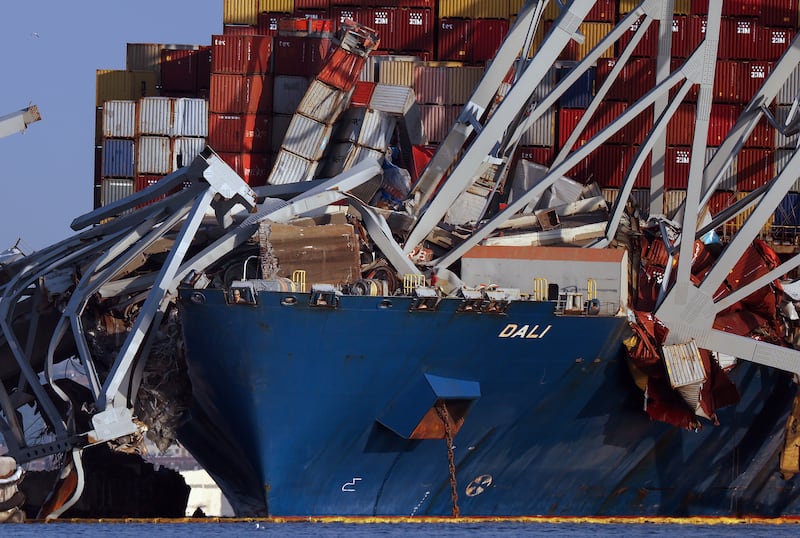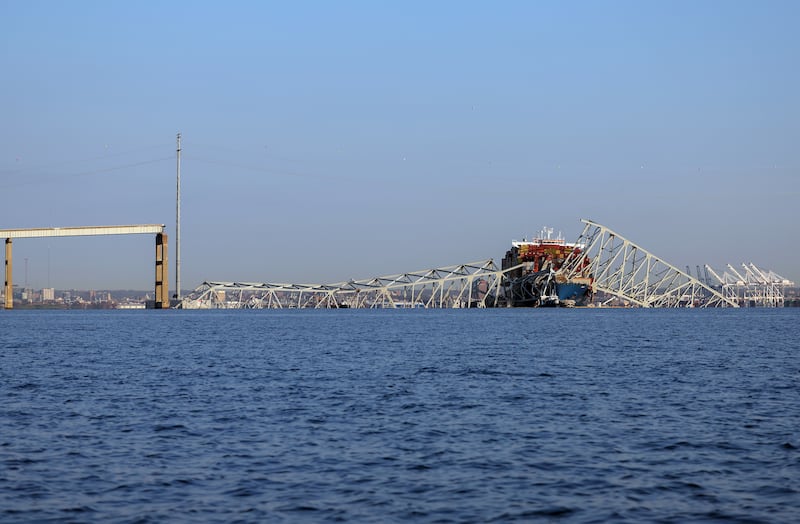The Rialto Bridge in Venice, which can lay claim as the most famous bridge in the world, is just 38 meters long and essentially decorative.
In the early hours of Tuesday morning, it and all the other famous landmark bridges were obscured by the 1.6 mile (2.57km) workhorse that was Francis Scott Key Bridge in Baltimore, which became known around the world from the moment it ceased to exist.
The image of the Dali cargo ship moving inexorably towards the left of the two main supporting stanchions and then tossing the structure as though it was made of papier mache, was at once toylike and shocking. By dawn, a vast search and rescue effort was under way for the six construction workers who had been working on the road surface of the bridge when the collision occurred.
Two other men were recovered from the water soon after the collision; one was hospitalised. Wes Moore, the governor of Maryland, tried to rally spirits in a press conference speaking of “Maryland tough” and “Baltimore strong”.
READ MORE
On Wednesday, after the bodies of two men, Alejandro Hernandez Fuentes (35) and Dorlian Cabrera (26), were recovered from a pickup truck in the murky waters, the search was called off.

Since then, questions as to how and why a bridge, which formed a city backdrop since 1977, could suddenly come down had begun. The investigation will be slow and repairing the damage will take many years and run into hundreds of millions of dollars. But in the immediate term, Baltimoreans are adjusting to the elemental fact that the Key Bridge is not there any more.
“It is quite difficult to process,” says Benjamin Schafer, professor of civil and systems engineering at Johns Hopkins University in Baltimore.
“We had live video but it didn’t seem real – and it’s still hard to believe that the bridge isn’t there; such a significant part of our infrastructure for so many years.”
The university arranged a forum on Wednesday with a panel of engineering experts to deal with the sudden influx of questions concerning bridge structures and maritime practices. But as Prof Schafer says, what happened involves a series of related factors which demand close examination.
“I guess I don’t think this so much of a bridge collapse. A bridge did indeed collapse. But it is a bridge that was destroyed. It was a destruction. It was an infrastructural systems failure. It is a complicated system that included the port, the shipping going under the bridge on a daily basis, then the failure event related to things that happened on the ship in addition to what happened when it hit the bridge,” he says.

In the hours after the collision, as the damaged vessel sat floating amid the metal carnage, it was noted that the peers, or supporting columns, were not clad with additional supports to absorb the collision. But even the untutored eye could see that the weight of the cargo ship – 116,000 tonnes slow-gliding at eight knots towards the bridge after the crew issued a mayday and reported a complete power failure – left the bridge in a hopelessly vulnerable position. The key to the prevention of similar collisions lies in measures put in place to divert ships from such points of contact.
“I think there’s little evidence that it’s economically feasible to create a protection system for a cargo ship that is coming at a full straight angle,” Prof Schafer says.
“So, the need for the protection system is to have diverted the ship away from the pier [support] ... so that a lot of that energy could be dissipated before it’s directly impacting the pier. Could we build a Fort Knox, you know, a nuclear bunker in front of every bridge? It’s structurally possible, but it’s not economically feasible. And so even in the most extreme bridge protection systems that we see, at this point, I remain unconvinced that in a similar incident that they would perform successfully.”
For Baltimoreans, the Key Bridge was, as a former mayor succinctly put it, “about work”. It was a visual symbol of the local economy and 30,000 cars crossed it each day. The devastation has halted what is the 11th largest port in the United States and the first port when it comes to the transportation of automobiles and the second for coal.
“This is no ordinary bridge. This is one of the cathedrals of American infrastructure,” said Pete Buttigieg, the US secretary of transport after arriving in the city on Tuesday.
“It has been part of the skyline of this region for longer than many of us have been alive. So, the path to normalcy will not be easy, it will not be quick and it will not be inexpensive. But we rebuild together.”

By Tuesday evening, the families of the six missing men attended a briefing.
“Why did we come here? For nothing. There’s no information,” Carlos Suazo, whose brother Maynor was among the missing crew, said afterwards in an interview.
“The US is going to rebuild that bridge one day [and] what we don’t want is for the bodies to stay there. We want them to be recovered.”
The deaths of the six men remains the chief tragedy of the incident and is set against the marvel that more lives were not lost. Lengthy and laborious as the investigation will be, the grainy clip of the collision contains the elemental facts. The ship lost power. It collided with the support.

Tinglong Dai, an expert in operations management and business analytics at Johns Hopkins, knew as soon as he saw the video that it would dominate the news across the globe.
“So this video we play again and again all over the world, along with those images of supply chain problems all over the world, along with the images of the ships getting stuck in Panama – this is not a national supply chain crisis,” he says.
“It just shows the power of imagery in influencing people’s perceptions. I don’t want to downplay the impact. But I do want to reassure everyone that we should be fully fine given the resilience of the global supply chain.”
- Sign up for push alerts and have the best news, analysis and comment delivered directly to your phone
- Find The Irish Times on WhatsApp and stay up to date
- Our In The News podcast is now published daily – Find the latest episode here






















